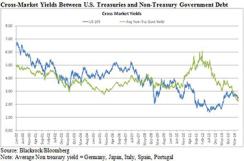In the first installment of BlackRock’s latest commentary on inflation and Treasury Inflation-Protected Securities, published this past Friday, I looked at forward market-implied real-rate valuations and suggested that the economy is likely in the process of transitioning to a modestly higher inflation regime. In this piece I argue that positive inflation momentum is apparent from both the top down and the bottom up. To provide depth to both perspectives, I will also examine cross-market-rate valuations.
The unemployment rate is a handy measure to determine slack in the labor market, despite being partially distorted at present by long-term structural unemployment. The recent drop in the Bureau of Labor Statistics’ (BLS) unemployment rate to 6.1 percent implies a much tighter labor market than that of a year ago. Soon we may begin to see signs of this tightening appear in the form of wage growth. For instance, the average hourly earnings for production and nonsupervisory workers have transitioned from a 1.3 percent gain in 2012 to a 2.4 percent gain as of July 3, when the BLS issued its latest report. In addition, anecdotal information gained from a recent National Federation of Independent Business survey shows that the number of firms “looking to raise compensation for workers” is approaching a postcrisis high. The correlation between this metric and the Employment Cost Index (ECI) — a wage measure to which Federal Reserve chair Janet Yellen pays particular attention — is quite evident. Consequently, I expect to see the ECI trend higher.
Recent research by M. Henry Linder, Richard Peach and Robert Rich at the New York Federal Reserve also points to positive inflation momentum. According to their report, published on the New York Fed’s web site in February, once the employment gap is closed — that is, when the non-accelerating inflation rate of unemployment (NAIRU) exceeds the unemployment rate — core services inflation picks up exponentially. With the unemployment rate at 6.1 percent and the Fed’s estimate of NAIRU at 5.2 to 5.5 percent, we are getting nearer to closing that gap. Furthermore, if the Fed’s estimate of NAIRU is too low and the unemployment gap has closed already, the potential impact on core services inflation could be significant.
Looking at inflation from a bottom-up viewpoint, there are multiple factors that pushed inflation lower over the past 12 to 18 months: predominantly, disinflation from medical and core goods components. The medical disinflation was driven largely by sequester-induced cuts to Medicare spending and from the expiration of patents of a few high-profile prescription drugs. Core goods disinflation has been impacted, we believe, by the strength of the U.S. dollar during the past 24 months, especially in comparison with the Japanese yen. This has depressed import prices as global exporters attempted to remain competitive in the face of the yen’s 30 percent depreciation. It is very important to note that neither the medical nor the core goods component is likely to be a drag on inflation going forward. Although we believe that the yen will continue to weaken, we think that it will do so at a much more moderate pace than witnessed recently.
While some disinflationary forces abate, what factors are likely to drive inflation higher in the quarters to come? In our view, the contribution from shelter in the form of rent and owners’ equivalent rent will continue to be a positive driver of inflation. Structural changes taking place in the U.S. housing market — namely, reduced supply in the face of increased demand — will keep pushing rental inflation higher. For example, high levels of student loan debt preclude a large percentage of potential first-time buyers from purchasing a home, forcing them into rentals. Moreover, a declining rental vacancy rate, in conjunction with the lagged effect of home price appreciation, will, in BlackRock’s view, provide a solid foundation for inflation increasing in the year ahead. Despite Yellen’s recent dismissal of some inflation data as “noisy,” we think a pickup in the underlying data will probably have policy implications of which investors must be very cautious.
Given that three major central banks — the Bank of Japan, the European Central Bank and the Fed — are holding rates at (or very near) zero, investors have been playing a game of global relative value, rather than positioning for fundamental growth and inflation differentials across regions. Indeed, peripheral European sovereign spreads have compressed closer to those at the core, making the U.S. market appear cheap to both. This has encouraged investors to buy U.S. duration. As long as the ECB continues to provide a soft credit backstop to the periphery, however, we believe this strategy may be short-lived.
We think the potential for both growth and inflation is much lower in the euro zone than in the U.S. given the backdrop of demographics and deleveraging. Consequently,euro zone rates should remain lower for much longer than rates in the U.S. Historically, U.S. yields have tended to trade substantially above European rates since the creation of the European Economic and Monetary Union. Barring an improbable breakup of the union, we are of the opinion that we are trending back toward spread levels and valuations consistent with those seen before 2008 (see chart).

We recognize that the present scarcity of high-quality fixed-income assets will likely result in U.S. rates remaining lower than valuations would otherwise suggest. One of the popular explanations for the recent trend toward lower rates has been a lower terminal funds rate stemming from secular stagnation. The Fed validated this view to an extent at the latest Federal Open Market Committee meeting by marginally lowering its terminal rate. This concept may turn out to be true in the long term. But we find the idea to be extremely time-dependent. Historically speaking, we believe the Fed has not been very successful at forecasting growth and inflation on a 12-month horizon. How, then, can we trust its ability to accurately forecast the long-term terminal rate? Granted, there are demographic headwinds in place and some structural impediments to full employment and growth, but is it safe to assume the politics in Washington will stay as divisive as they are? What if immigration reform is enacted? What if we embark on a nationwide infrastructure upgrade? Will regulatory uncertainty continue to hang over the financial sector longer term? These are some questions to consider when looking at valuations of the long-term neutral rate.
There are certainly factors in place that will keep rates lower than they should be for some time to come. That being said, we think that investors should be wary of a transition to a higher-rate regime at some point, as growth and inflation become more influential in determining valuations.
Martin Hegarty, managing director, is head of BlackRock’s inflation-linked bond portfolio management team within the institutional multisector group in New York.
Get more on macro .






